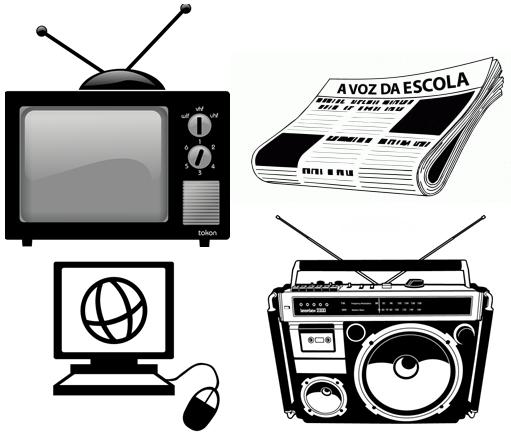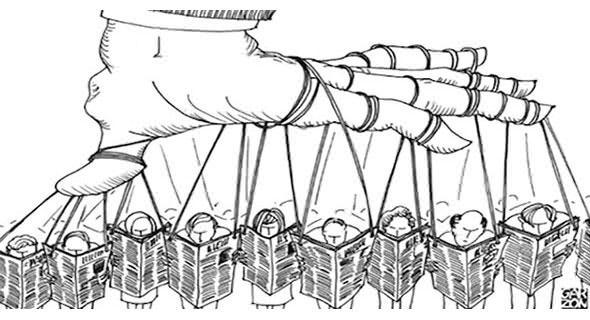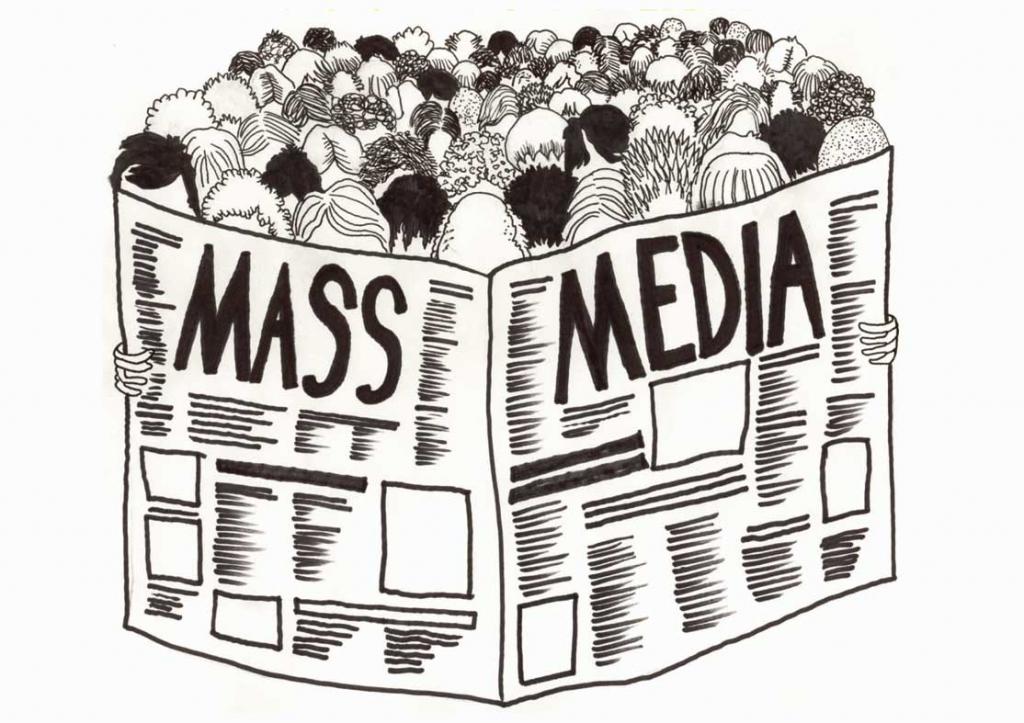Experts have calculated that a modern person processes two to three times more information daily than his average ancestor from the 19th century. What was the reason for such a rapid increase in the consumption of an intellectual product? This and other related questions will be answered in this article.

What is the media?
It would seem that this question should not cause difficulties. Most people are likely to answer it like this: the media is any publication that comes out at any frequency and is designed for a certain audience. However, such a definition is not exhaustive. In 2012, the latest version of the law on the media saw the light of day. Which source can be officially attributed to the media?
According to the current legislation, only publications that are issued in circulation of at least 1000 copies and are published at least once a year can be considered as such.
If a newspaper, magazine or other print media meets these two requirements, then they must be registered with a special state organization in charge of such issues. It is called Roskomnadzor.

As for broadcasting, to obtain the right to broadcast at certain frequencies, you must obtain a license.
Wall newspapers
This format of the press, although it is very popular in various educational institutions, as well as in some enterprises, still can not be counted among the media. Why? Firstly, the circulation of such publications is usually limited to one copy, and secondly, it is extremely difficult to take into account the number of readers of such newsletters. Therefore, wall newspapers are not subject to mandatory registration.
Modern media
The situation is much more complicated with the Internet. From the moment of its appearance until recently, the debate about whether it can be put on a par with the traditional type of media has not ceased.
Specialists who were inclined to rank the world wide web as the media, usually argued their point of view this way: the information provided through the Web is no different from that published on analogue media. The peculiarity consists only in the method of its transmission.

This opinion often provoked the following objections:
- Not all materials published on the Internet are designed for a mass audience. For example, there are pages devoted to the activities of relatively small social formations (collectives of commercial firms, university training groups, and so on).
- The second objection is that even sites owned by the editors of large print media and television channels, for the most part, do not constitute an independent source of information. Materials on them often only duplicate those articles and programs that appear in the mainstream media.
Internet Status
In 2014, a final decision was made. Now sites on the World Wide Web have the right to have the status of the media, but may not be related to them.
Compulsory registration is subject to blogs whose attendance exceeds 3,000 people per day. The so-called "three thousandths" must be included in the national registry. After registration, the founders and employees of a large site receive rights and obligations along with representatives of the rest of the press.
Bloggers whose website is visited by more than 3,000 people a day can count on accreditation for various events, like other journalists.

Thus, the question of what the media can be answered as follows: these are publications targeted at thousands of people and coming out with a certain frequency. As for the frequency of updating the material, there are no specific rules on this subject yet. It is known that, unlike newspapers and magazines, information blogs publish new articles not at any frequency, but with the accumulation of information.
The Russian press in facts and figures
It may seem strange, but today the number of online media is not so great - about seven hundred. For comparison, we can cite figures related to the print media. About 20,000 different newspapers and more than 10,000 magazines are registered in our country. The most popular weekly publications. The maximum number of Russians are attracted to newspapers and magazines covering the issues of cinema and television, as well as publishing various articles about cooking and fashion, that is, related to women's issues.
Advantages and disadvantages
Among the positive trends of recent times can be called a sharp increase in print media. So, from the late nineties of the 20th century to the present moment, the number of newspapers and magazines has increased by several thousand items. However, with such a rapid increase in this indicator, the quality of the press still leaves much to be desired. Many researchers in the field of mass communications say that the Russian media almost completely ignore the requests of the audience for which they are designed. Almost all newspapers and magazines do not provide “feedback” to their readers. Materials are published in them, based on the subjective opinion of the founders and individual authors.
Media Classification
There are several criteria according to which you can divide the entire press into subgroups. One such item is financing. On this basis, it is customary to classify the media as state or commercial. The share of the latter currently outweighs in our country.
In total, there are about 10 state newspapers and magazines and about 20 television channels in Russia.
Distribution area
Another criterion is the territory that a particular media covers. On this basis, all media can be divided into:
- Nationwide, that is, those that are published in large numbers and distributed throughout the country. An example of this kind of media might be Rossiyskaya Gazeta.
- The second type of media on a territorial basis are regional. These are newspapers, magazines and other publications that are designed for residents of a particular area. The region of coverage does not have to coincide with the official borders of a particular region. There are, for example, various publications intended for residents of the Urals. This also includes newspapers and magazines for one or another national minority living in the territory of the Russian Federation.
- The third group of this variety is the media, addressed to small audiences, for example, employees of a large enterprise.
- Also, classification can occur on a thematic basis. There is a generally accepted division of the media into popular science, entertainment, devoted to art, various hobbies and others.
The history of the term media
The fact that such a media as a set of periodicals was first discussed in the Soviet Union in the early seventies. This term appeared in our language as a literal translation from French.It is worth mentioning that in the homeland of this concept the phrase “mass media” by the seventies of the 20th century almost completely went out of use. Therefore, we can say that Soviet sociologists borrowed the name, which in France at that time was already obsolete.
What is the media, from the point of view of Europeans? And for what reason has the term been used for a long time in French out of use?
Dialogue instead of a monologue
By the 1960s, an opinion among European journalists was firmly rooted that the press should work closely with its audience and, instead of presenting information on the basis of a monologue, conduct two-way communication, that is, dialogue. In addition, new forms of media interaction with each other were widely used.
Communication with the viewer, reader and listener
That is why in the sixties and seventies a new term appeared - the mass media. This phrase, according to experts, much more accurately expressed the interactive nature of the modern press.
Communication with those who were intended for materials published by a particular publication could have been open, with the help of letters, as well as telephone interviews and interviews that special correspondents took from radio listeners and viewers. Feedback was also made indirectly. One of the technical innovations with which it took place was the peoplemeter device. This device was integral with the television remote control and sent data about which television programs were watched by viewers to a bureau studying statistics.
Media at the service of business and politicians
The measurements described above were carried out not only to improve the quality of the material. They also measured the rating of each specific program and determined the most promising time for publishing advertisements.
It is also not a big secret that the media often acted as an instrument of political propaganda.
Public Opinion Technology
What media influence thoughts and moods in modern society?
As an answer to this question, we can provide interesting data on one of the theories concerning the press.

This hypothesis is called the “Agenda Phenomenon”. According to her, the media can not always impose their opinions on people, but they are able to focus their attention on certain problems. Indeed, it is safe to say that no matter how important this or that event, but if there is no mention of it in the press, this phenomenon may go unnoticed by the majority of the country's population. On the contrary, if some insignificant topic is mentioned several times in the news bulletins, then many people will begin to think about this issue by inertia. This technique has been widely used and is used to divert the masses from problems of a global nature and to shift attention to minor or nonexistent phenomena.
History of the Russian press
It is known that the first domestic newspapers appeared immediately after the invention of printing by Ivan Fedorov.
Along with Russian publications, representatives of the elite of past centuries often subscribed to the foreign press. In some noble families, the Times newspaper, which has been collected for decades, has been handed down from generation to generation. Radio broadcasting in the Soviet Union appeared in the first years of the reign of the new government. In the early twenties, a regular broadcast of the first channel was established. After more than 20 years, after the Great Patriotic War, a second program appeared, which later became known as the "Lighthouse". The first television channel was opened in the early thirties of the 20th century. This was the development of the media in Russia.

Media interaction with each other
In addition to feedback, which is carried out through surveys of the audience, as well as using various technical devices, contacts are also made between the media themselves. Such cooperation can be as simple as when individual employees agree among themselves on the coverage of the same problem from different points of view, as well as a more complex one, established through various agreements.

For example, such an interaction can be used to cover major political and sports events. During the Olympics, the country's population will receive much more complete information about the competitions, if television and radio take on the live broadcast of the events, while a more subtle analysis of the events, interviews with coaches, athletes, etc., will be published in print.
Conclusion
The media have a long history. From time to time, new types of media appear. However, traditional newspapers and magazines are still in high demand.
